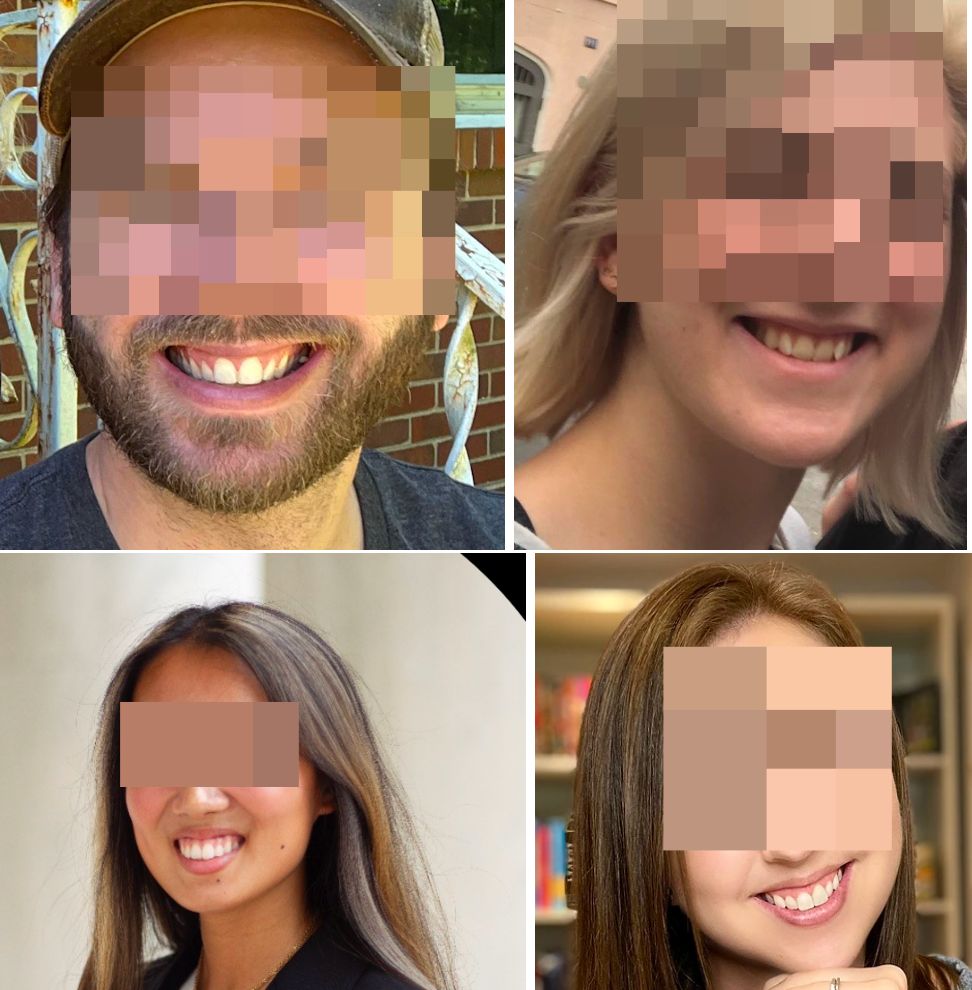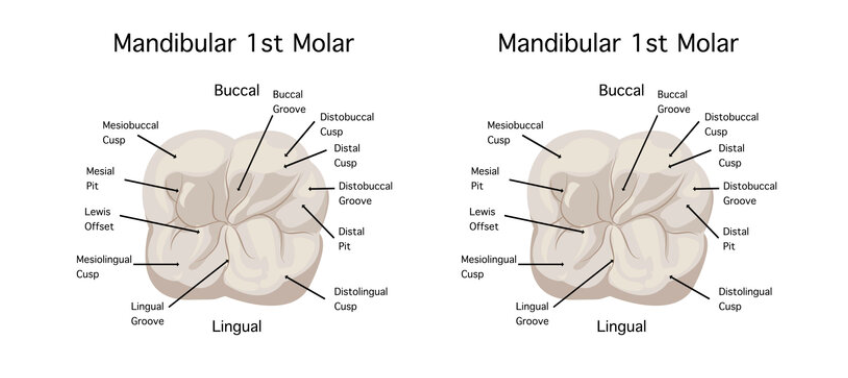
Imagine going to the dentist for straighter and better teeth as a child, trusting your parents, and they pull your premolars and give you weird narrow dental arches and gummy smiles instead. “Rabbit teeth” occur when premolars are extracted for braces due to the false belief that the teeth should fit the palate rather than expanding the jaw through Mewing or orthotropics. Once you see it, you start seeing it everywhere, and it’s nothing but a false appearance of straight teeth because how can a dental arch so narrow and so unnatural be complete?
TMJ Dislocation
Something else that is a common cause of malocclusion is that one of the TMJ joints is displaced, causing the bottom jaw to shift to the left, which changes the alignment of the top jaw. I’d estimate I see this frequently, somewhere less than 1 in 25 but enough to where it’s noticeable.
This also causes deviated septum as the upper jaw shifts on one side, causing one nostril to narrow and the other to expand.
Orthodontics will try to treat this without addressing the underlying issue, leading to the teeth appearing straight but having a misaligned face if one looks closely. Their dental arches are more normal, but they have this misalignment.

Though surgery is often recommended as the only option, it’s actually possible to put it back manually. I tried doing this multiple times by pulling the jaw down and then pushing it back up. However, it often seemed to fall back into dislocation. I recently tried a new method to put the jaw back which surprised me: it involves pushing into the TMJ in the direction of the dislocation. This one may seem to work.
The TMJ issue started for me after trying to do a backflip as a teenager. I landed slightly on my neck. I heard some clicking in my right ear, and it went away, so I just assumed there wasn’t an issue. I’m genuinely surprised I did not notice this for years. However, I talked to another dude, and he said that most of his family has this problem.
If this dislocation is caused by hyperplasia of the condyle, I doubt someone can put their jaw back into place. I don’t know what percentage is dislocation versus congenital, but I’d guess that most of it is a result of dislocation.
Here are some solutions for TMJ jaw fixes.
- https://www.youtube.com/watch?v=YO30lYQJV0k
- https://www.youtube.com/watch?v=-PsIqBytWaI
- https://www.youtube.com/watch?v=59pVtiR-moU
- https://www.youtube.com/watch?v=N3edJvp5DoA
Here are the best threads I’ve found to actually understand the issue of TMJ dislocation and what is at hand.
- https://www.physio-pedia.com/TMJ_Disc_Displacements
- https://old.reddit.com/r/TMJ/comments/11vq81z/here_are_the_phases_of_tmd_provided_by_dentist/
Jaw Flatness and Absorption
Old people have this look where their jaws go upwards because the lack of teeth in the back (molars are generally lost first) causes bone resorption. There are also some people with very flat jaws, which looks weird, but I am not sure what the cause is. Is it tooth extractions? Or are flat jaws actually normal and it’s modern people that have chins which are too thin? Or are they caused by wisdom teeth extractions, causing the chin to angle upwards leading to a visual effect?
TODO: add some pictures of this
Third Molar Extractions
Third molar extractions cause the following issues:
- a loss of bone, as the embedded tooth previously supported thegum
- the backwards and inwards curving of teeth on the lower jaw
- (I think, but not 100%) increased gummy teeth in the upper jaw as the top jaw is angled to adjust for the change in shape of the bottom jaw
Collection of Dental Tips
Brushing and gums
- Brush softly, otherwise you might get gum recession
- Brush in small, concentric circles
- Use a soft-bristled toothbrush
- Angle it toward the gum so you can brush under the gumline, but also angling it away and down from the gum seems to somehow work too
- Gum recession is usually caused by loss of the underlying bone
- If your gum is healthy and your cuticles on your hand regrow quickly showing high cellular metabolism, you wouldn’t see that big of an effect from bad brushing.
- Prescriptive “twice a day” doesn’t make sense. What if someone has been fasting or adheres to a ketogenic diet? Their teeth would be relatively clean and there would be little need to brush. If I had to guess, I probably brush about 1.3 times a day. You can usually feel it when your teeth are dirty.
- Example of article with good methods
Flossing
- Create a C-shape when flossing
Flossing is pretty much the same as what you usually do, but their technique is a bit better because they do it so much. For example, they might not reuse floss that was already between the teeth and would instead wrap the used floss around their finger and position some new floss for the next set of teeth. You want to make sure to get into the edges while not spreading extra bacteria around your mouth.
One thing to note is that because the molars come in 5 cloves, they leave a gap in between the molars where it is not possible for the floss to reach it. Imagine putting a string on top of two peaks or two mountains.
The significance is that if not physically removing bacteria were really the true and only cause of cavities, then everyone should have cavities there.
There are some studies about PFAS being in floss, but the issue is that floss without detected PFAS may have more toxic chemicals. I tried some silk floss but didn’t like it so much. At the moment, I don’t have a good answer for this, but it’s worth keeping in mind. Perhaps they make floss from natural fibers?
Update April 2024: MUJI seems to make good coating-free floss that is more like string. Maybe can use semi-thick sewing string instead?

Polishing
It wasn’t until I was around 18 or 19 that I realized the apple-tasting toothpaste mixed with abrasive sand is a terrible thing to do. Do not let the dentist polish your teeth 20 times! 10 years, 2 times a year, 20 polishings. Polishing teeth is the removal of enamel with no benefit.
Gum Pocket Testing
This is when the dentist measures how deep your gums go using a pointy metal stick with mm grooves on it. 1-2mm pockets are good, 3-4mm medium, above that is bad. However, this doesn’t represent the degree of bone loss around the teeth, which is generally indicated by spaces between the teeth as shown in the gum. You can kind of tell just by looking at the teeth if the bone around it is receded.
Anecdotally, spending lots of time in the sun made my gums grow higher up, probably because the bone was growing, but this quickly reversed in the fall when school started again. You need at least multiple hours of sunshine for this to work. Gum loss starts not at the gums but with the loss of bone.
Acid
- Don’t brush after eating acidic things, the enamel may wear down faster
- Don’t brush after vomiting
- Use a straw to drink acidic things
Plaque
- Usually you can feel plaque on your teeth so you know when to brush
- Chew a paper towel to remove the plaque on teeth
Dentists
- Don’t polish with abrasive sand at the dentist
- Don’t use bleaching/whitener
- Avoid X-rays
- “It was only after a multitude of dentists had a finger amputated that it became standard practice to ask the patient to hold the film, while the dentist stood safely back away from the rays.” - Ray Peat
- Care should be taken that the lead vest covers your thyroid. It is also worth noting that X-Rays, despite being considered safe in the amounts given, may actually be more harmful than expected. Teeth are alive and subjecting them to high levels of radiation is not helpful, as the idea of a ”minimum dose” is highly misleading. It simply means it damages your health, but not enough that other people would notice it. If you know something is harmful in any quantity, there is little reason to subject yourself to it.
- Avoid veneers
- Avoid gum contouring
- Avoid “protective fillings”
- Ultrasonic tooth scalers exist online and you can buy them from AliExpress but you should probably do it manually first
- Malicious money-making
Fluoride
I think fluoride does work. My understanding is that the fluoride replaces the phosphate in hydroxyapatite. Now, is it beneficial to have that replaced by fluoroapatite? Based on the historical precedence, I would say no, for similar reasons that the calcium in bones can be replaced be strontium, one row below on the periodic table hence exhibiting similar bonding properties, but probably not being good for people.
If you really aren’t sure, I would say to read the original study by Henry Dean for yourself. Here’s a documentary too. Here’s what stood out to me in the study.
- There was a graph showing increased fluoridation (up to 3ppm) led to decreased indicence of cavities with an inflection around 1ppm, which is near the official basis of 0.7 today.
- Over 90 percent of ingested fluorine is eliminated through the urine and the sweat. This strongly suggests that the body does not like fluorine.
- Oh, they also experimented on large amounts of the population and nature by dumping sodium fluoride into Lake Michigan so it reached 1ppm.
Toothpaste
Sensitivity toothpastes have become all too common. However, their mode of action is the blockage of the dental tubules. Generally, fluid flows out of the tubules. It has been shown that poor nutrition increases sensitivty and causes fluid to flow into the dental tubules. I strongly recommend against any sort of anti-sensitivity toothpaste as it seems equivalent to covering your sweat glands and skin with plastic wrap.
Supposedly triclosan is bad. No opinion on some other common ingredients yet such as sodium lauryl sulfate, need to research this more. Not sure about brushing with baking soda due to abrasiveness. People chew miswak, a stick, for health, but I’ve always chewed a paper towel instead.
Misc Tools
- Use a tongue scraper
- After rinsing my mouth with crushed nystatin, biofilms on the tongue were significantly reduced. This will be significantly affected by diet.
- Remove tonsil stones by digging around the pockets in the back (not tonsils!)
- Anecdotally from a friend, tonsil removal caused more colds to occur. Removal of any part of the body that cannot be replaced (appendix, gallbladder, tonsils, teeth) is extremely foolish. Do humans know more or does nature know more? Humans should not be arrogant and say that it is 100 percent vestigial.
- A water flosser may be effective for going under the gumline
Misc Stuff
- Electric toothbrush may cause retina dislocation?
- Kissing spreads bad mouth bacteria
I’m not sure about what the best practices for toothpaste and floss are. Ideally, you’d want a toothpaste that isn’t toxic, nor would you want microplastics from the floss. But I’m struggling to find any substances that are suitable.
There are good manual toothbrushes from Curaprox. For electric, the Xiaomi T300 is good with USB-C, around $15. Equal in quality to some $75-$100 toothbrushes at Costco. Philips has really gone downhill: my first Philips toothbrush was nice and sturdy, but they made the next version of it cheap, thin, and barely able to hold a charge due to downsizing the battery.